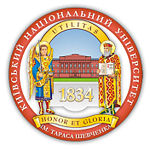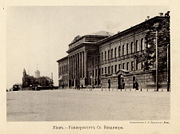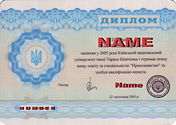Kiev University
| National Taras Shevchenko University of Kyiv | |
|---|---|
| Київський національний університет імені Тараса Шевченка | |
 |
|
|
|
|
| Motto: | "Utilitas honor et gloria" (Latin) |
| Motto in English: | Utility Honor and Glory |
| Established: | 1834 |
| Type: | Public |
| Rector: | Leonid Guberskyi |
| Staff: | -- |
| Students: | 20,000 |
| Location: | Kiev, Ukraine |
| Affiliations: | IAU |
| Website: | www.univ.kiev.ua/ |
Kiev University or officially the National Taras Shevchenko University of Kyiv (Ukrainian: Київський національний університет ім. Тараса Шевченка) is a university located in Kiev (Kyiv), the capital of Ukraine. It was founded in 1834 as the University of Saint Vladimir, and since then it has changed its name several times. Currently, its structure consists of fourteen Faculties (academic departments) and four Institutes.
Contents |
Overview
Kiev University is an institution of higher education that trains specialists in many fields of knowledge and carries out research. Although this description can be applied to many other institutions of this type, Kiev University enjoys a special status in the field of higher education in Ukraine. It is considered the best university in Ukraine[1] and a major centre of advanced learning and progressive thinking. It consists of more faculties and departments and trains specialists in a greater number of academic fields than any other Ukrainian educational institution.
Kiev University is named after Taras Shevchenko, a major figure in Ukrainian arts. Its reputation transcends the boundaries of Ukraine. Since the time of its foundation, 160 years ago, the University has been generating progressive ideas, shaping the Ukrainian intellect, and providing champions of national liberation in Ukraine. It has always upheld the Ukrainian freedom-loving spirit.
History


Pre-history
Kiev University dates back to the first half of the 17th century. The Kyiv-Mohyla Academy, founded in 1632, provided the foundation upon which Kiev University was subsequently built. This Academy, whose history spanned almost 200 years, was the first establishment of higher education in Ukraine. Among its students are many prominent figures of Ukrainian cultural development: Meletius Smotrytsky, Feofan Prokopovich, Hryhoriy Skovoroda, and many others.
For many years it was realized that the city of Kiev needed a new type of university. Pressure on the authorities to allow the creation of such a school was growing, but it took many decades before this idea was realized. Since the Russian autocracy feared the new school would turn into a centre of Ukrainian national liberation activity, one must say that such fears were not at all groundless. Kiev University did become a focal point of national consciousness.
Saint Vladimir
The University was founded in 1834 and named after Saint Vladimir, the ruler who Christianized the Kievan Rus'. This name was chosen by the authorities of the Russian Empire, where the role of Orthodox Christianity was immense, and may have reflected the ongoing importance of Kiev as the cradle of Eastern Christianity for the entire Empire.
The first 62 students started their studies at the university in 1834, in its one faculty, the Faculty of Philosophy, which had two Departments: The Department of History and Philology and The Department of Physics and Mathematics. There were new additions to the original department in 1835 and 1847: the Faculty of Law and the Faculty of Medicine. Later on, the original Faculty of Philosophy was divided into two separate units: the Faculty of History and Philology and the Faculty of Natural Sciences. There were no more additions to the number of departments until the 1920's.
The walls of the main building are painted in red while the tops and bottoms of its columns are painted black. These these refer to the colours of Saint Vladimir's Order (created in 1782), whose motto is "Utilitas, Honor et Gloria".
Taras Shevchenko
In 1939, Kiev University was re-named after Taras Shevchenko. Upon graduation from Imperial Academy of Arts in Saint Petersburg, then the capital of the Empire, Taras Shevchenko returned to Kiev, and between 1845-1846, was employed by the Archaeological and Ethnographic Commission at Kiev University until his arrest in 1847.
Notable members
Organization

At present, the student body of Kiev University totals about 20,000 students; this number includes almost 2,000 students at the Institute of International Relations which is attached to Kiev University.
Kiev University maintains contacts with many universities and research centres throughout the world.
The newly acquired independence of and changing situation in Ukraine have created new challenges for Kiev University, which is contributing to the effort to create a radically new political, social, and economic structure in the country. Kiev University is obliged to improve its system of training since its graduates are to work in various segments of the political, social, and economic system of independent Ukraine. Kiev University graduates are expected to be highly qualified, patriotic, and aware of the tasks facing the new Ukraine; they must be open to the national ideals, and feel responsible for what they are required to do; they are expected to be able to demonstrate a creative approach in solving the pressing problems of today and tomorrow, and to think in terms of long-term and wide-ranging reforms. In other words, the university is striving to achieve a truly universal character in the training of its students.
These are the 14 departments and 4 institutes into which the university is divided:
- Department of Biology
- Department of Chemistry
- Department of Cybernetics
- Department of Geography
- Department of Geology
- Department of Economics
- Department of History
- Department of Law
- Department of Mechanics and Mathematics
- Department of Philosophy
- Department of Physics
- Department of Radiophysics
- Department of Sociology and Psychology
- Preparatory Department
- Institute of Philology
- Institute of Journalism
- Institute of International Relations
- Military Institute
References
- ↑ "200 of the best higher education schools in Ukraine" (in Ukrainian), Dzerkalo Tyzhnia (March 30, 2007). Retrieved on 2008-08-09.
See also
- List of colleges and universities
- Kiev
- Liceum Krzemienieckie
External links
- Kiev University Website (Ukrainian)/(Russian)/(English)
- (Biological Department)
- (Mathematics Department)
- (Radiophysics Department)
- (Physics Department)
- (Chemistry Department)
- (Department of Cybernetics)
|
||||||||||||||